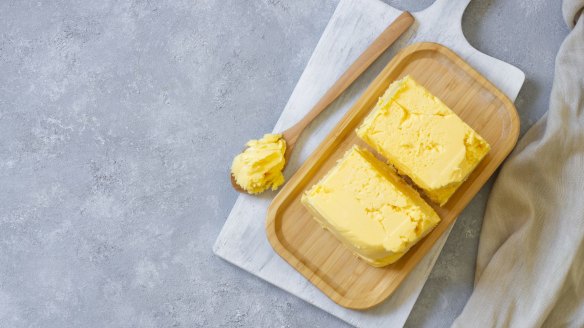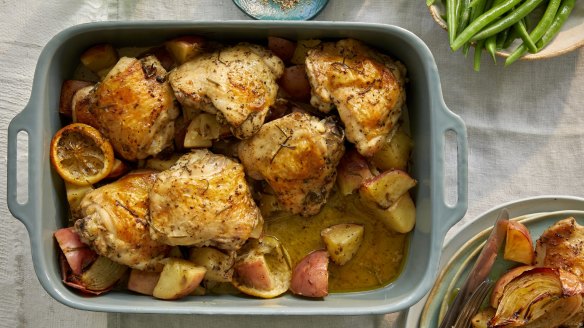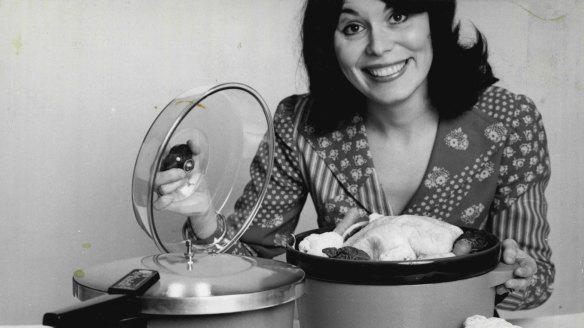Seven cost-cutting food hacks from older generations

- The thrifty 50: budget-friendly recipes, meal prep and shopping tips
- Rachel Khoo's roast chook recipe (above)
With the cost of just about everything soaring, we're all looking to be thriftier in the kitchen. Thankfully, there are a multitude of hacks to save money, from buying in bulk to saving vegetable scraps for stock. Mostly, they're common-sense practices that were second nature to previous generations.
Recently, I've taken to jointing a chicken myself. It's a rudimentary affair (a butcher wouldn't approve) but, with a sharp knife and dedicated secateurs, I can prise two breasts, two thighs, two drumsticks and two wings from the bird. Even if free-range or organic and costing around $20, that single bird can yield four or five meals if I'm cooking for myself. If I make enough stock, it can stretch to six or seven.

The decline of kitchen thriftiness has coincided with the rise of supermarkets and convenience foods: ready meals, grated cheese, pre-chopped vegetables. Wonderful in many ways, but it can encourage a lax attitude.
"Our mothers and grandmothers knew how to eke out a small budget to feed a family," writes Darina Allen, founder of the Ballymaloe Cookery School, in Forgotten Skills of Cooking. "Given a chicken or a fish, they would have simply rolled up their sleeves and got on with eviscerating or filleting it. It mightn't have been perfect but they just did it in their pragmatic way."
As prices continue upwards, now is the time to unearth those long-forgotten skills.

1. Be sensible with best-before dates
The date only refers to quality, not safety and, as Allen writes, the dates have "undermined our confidence and ability to judge for ourselves when food is safe to eat". Yoghurt past its best-before date, for example, can be used in baking or for a marinade.
2. Make your own butter
Making butter at home is quick, easy and thrifty. Simply buy double cream, whisk in a stand mixer for five minutes and it'll separate into butter and buttermilk after about 10 minutes. 600ml of cream makes about 250g of butter, while the buttermilk can be used for baking, pancakes or marinating meat.
3. Buy meat on the bone
Meat on the bone tends to be cheaper than fillets and is much tastier, says recipe writer Silvana Franco. "A couple of lamb chops or pork ribs in tomato sauce for pasta will get far tastier results than using mince or cubed meat. The meat will stay juicier." If you want boneless, remove the bone yourself: chicken thighs are much cheaper this way and the bones can be used for stock.
4. Use meat sparingly
Reducing meat consumption will help lower the food budget, but you don't have to cut it out completely. A couple of rashers of chopped-up smoky bacon can flavour a stew, a few slices of chorizo work wonders on a tin of white beans and cheap offal such as chicken liver adds depth of flavour to a pasta sauce.
5. Be precious with leftovers
Thriftiness relies on squeezing out the value in every ingredient. Patrick Withington, head chef at Erst in Manchester, keeps leftover meat fat, drizzles beef dripping over flatbreads and adds pan juices from a roast chicken to lemon and mustard dressing for a warm chicken salad with olives, capers and rocket.
Neil Campbell, head chef of Rovi in London, uses chicken or bacon fat instead of oil in soups or stews.
Roberta Hall-McCarron of the Little Chartroom and Eleanore in Edinburgh always has puff pastry in the freezer for a galette made from leftovers. "I put a layer of cream cheese on the base of the pastry then add whatever meat or veg I have. Fold the edges and bake until the pastry is golden."
6. Dig out your pressure cooker
With energy costs up, cutting cooking times is crucial, too. Pressure cookers can cut cooking times by up to 75 per cent and some electric versions use 70 per cent less energy. "They retain so much more flavour and nutrients as nothing evaporates in the cooking process," says Farokh Talati, head chef of St John Bread and Wine in London. "I use mine for curries, dals, potatoes, whole chickens, soups, braises, pork joints, stocks, steamed puddings. The list is endless."
7. Freeze on-the-turn vegetables
Vegetables are the food item most likely to be thrown away. Aktar Islam, chef-patron at Opheem in Birmingham, recommends judicious use of the freezer. Vegetables on the cusp should be blanched briefly in boiling water, quickly submerged in ice water, then frozen in air-tight containers. "My favourite way to use up various frozen veg is in a biryani," says Islam. Herbs freeze well, too.
The Telegraph, UK
The best recipes from Australia's leading chefs straight to your inbox.
Sign up- More:
- How to